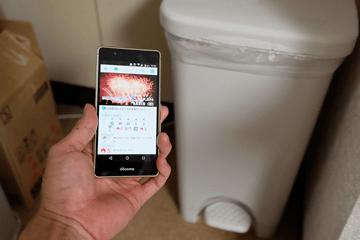The "HUAWEI P9" has attracted attention for its camera jointly developed with Leica, but I feel that the non-camera functions are also quite satisfying. When I actually continue to use it, there are many things that I think, "This is convenient," and "It's smart." It will let you know when the battery is in a pinch before it wastes power, or casually tell you about useful functions when you turn it on. It may be said that it is a smartphone like a “competent secretary”.
The HUAWEI P9 comes pre-installed with an app called "Device Management" that checks and optimizes the status of the device. The frequency with which these apps are used differs from person to person, and I think that there are more than a few people who do not know how to use them properly. But the P9 does a good job of notifying me when it's time to take advantage of this. For example, when an app that consumes a lot of battery is left running, or when you think you should clean up your storage, you'll get a notification, tap it, and you'll be able to start optimizing right away.
You can check the power consumption of each app by tapping it, and you can close the selected app. You will receive a notification in situations where it is better to use "Wi-Fi+", which can remove files with one tap, and will guide you to the settings
"Wi-Fi+" is also a function that I found useful in the process of using it. Simply put, this is a function that smoothly switches between mobile data communication and Wi-Fi. Even if Wi-Fi is turned off, if you approach a Wi-Fi base unit that you have connected to in the past, Wi-Fi will automatically turn on and connect, and the Wi-Fi router that you set up will automatically turn on Wi-Fi. Even if there is, if it is not connected to the net, it will not be connected.
Have you ever connected to public Wi-Fi while out and about, but didn't get the speed you expected and turned off Wi-Fi? In such a case, even if you go home with Wi-Fi turned off, it will automatically connect to your home Wi-Fi.
It's a small detail, but the notification when the terminal is connected to the computer is also thoughtful. "Photos" and "Files" items are displayed on the notification screen. For example, if you tap "Photos", you can import photos to your computer. I use a Mac, but it can be imported smoothly into "Photos" on a Mac.
On the HUAWEI P9's "Settings" screen, there is an item called "Manage data traffic". This can also be accessed from the "Device Management" app mentioned above, but here you can quickly check the data usage of the frequently used apps. You can analyze your smartphone usage, and I think it will be useful for people who use smartphones with cheap SIMs.
The configuration of the notification "Settings" menu that is displayed when connecting to a computer with a USB cable is also slightly different from the standard Android. > Another thing that is casually useful is the "scroll shot". This is a function that allows you to take a vertically long screenshot. Tap the "Screenshot" icon on the shortcut (quick settings panel) and tap "Scroll shot" on the following screen to scroll the displayed screen slowly and capture the position until you stop tapping as a still image. mechanism that can be saved. It's useful when you want to read web pages offline or when you want to save your Twitter timeline."Screenshot" operation is possible from shortcut You can save such a long screen in JPEG format

